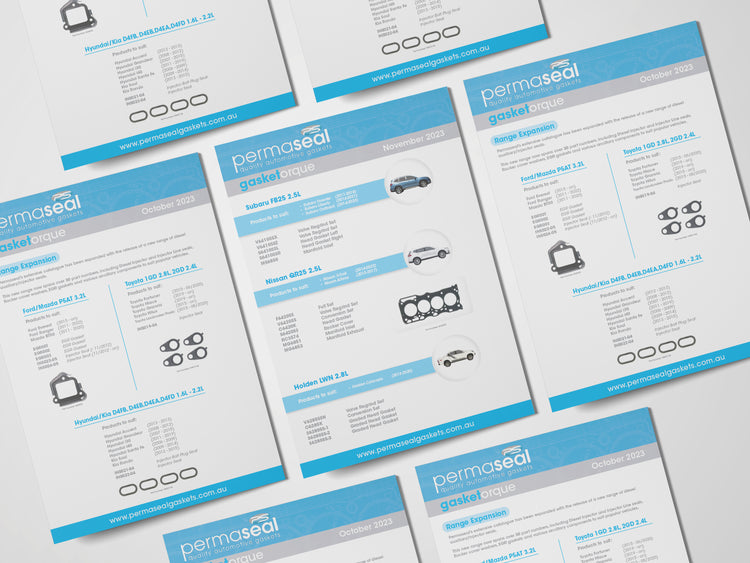
Cooling Systems
More than half of the head gaskets received by AA Gaskets Limited for evaluation that have failed in service, clearly show signs that can be directly attributed to engine overheating. The reasons for overheating are many and varied. Quite often however, the condition and proper functioning of an engines cooling system is ignored.
It is the job of an engines cooling system to absorb, transport and dissipate that heat. In today’s modern vehicles, the cooling systems are smaller and are designed to operate at near maximum capacity. It is therefore essential that the cooling system is properly maintained to the manufacturers specifications.
Following a major engine repair or rebuild it is essential that the vehicle's cooling system is thoroughly checked. Radiator tanks and cores, thermostats and thermo switches, fan belts and water pumps should all be inspected and if necessary, replaced. The cooling system should be drained, thoroughly flushed and refilled with fresh coolant.
One of heats basic principles is that it will always flow from an area of higher temperature to an area of lower temperature. Corrosion and or contamination can severely reduce a cooling systems ability to operate efficiently and effectively. In basic terms, corrosion is the deterioration of a solid by a chemical or an electrochemical process. Corrosion is assisted by moisture and oxidation. When we apply this to an automotive environment, the solids are the engines metal components which are immersed in a chemical, the engines coolant. These metals are subjected to several different forms of corrosion; cavitation, chemical, crevice, galvanic, general and pitting corrosion are all common in automotive cooling systems. In the case of the more modern engine of the 90s, we must add to these stray current corrosion.
Cavitation corrosion is due to the collapse of air bubbles against the walls of the casting. This exploding action of the air bubbles erodes the protective film formed by the coolant and eventually the oxide layer of the metal, exposing the casting to corrosive action. Preventative maintenance can greatly reduce the occurrence of cavitation corrosion by maintaining the layer of protective film over the casting as well as suppressing the occurrence of foaming and the formation of air bubbles.
Chemical corrosion can be caused by mixing different types of coolant or having an incorrect amount of ethylene glycol in the cooling system. Chemical corrosion can also occur when the coolant has exceeded its service life and the protective properties of the corrosion inhibitors have been severely depleted. Again, the best cure is prevention through proper maintenance of the cooling system.
Crevice corrosion can occur in areas where coolant flow is poor and small amounts of coolant can stagnate. Typically, this type of corrosion can occur where radiator and heater hoses join clamping areas, such as thermostat housings and water outlets. Hose clamps should be positioned as close as possible to the lip of the outlet or housing to prevent coolant from penetrating between the ID of the hose and the OD of the outlet.
Galvanic corrosion or electrolysis occurs when two or more dissimilar metals are in contact with each other or immersed in a fluid capable of conducting a charge. For example, if copper particles from the radiator, carried by the coolant, coat an aluminium housing, a galvanic cell is formed as the two metals react chemically producing an electric charge. The aluminium becomes the sacrificial metal, the housing begins to corrode.
Eventually the corrosion will completely perforate the aluminium housing.
General corrosion will occur where metal is contact with both water and oxygen. A common result of general corrosion is rust and scale which can block radiator tanks and cores. Even a relatively thin layer of rust / scale on an engines metal component can greatly reduce the transfer of heat from the components and into the coolant.
Pitting corrosion is a very localized form of general corrosion, which penetrates deeply into the metal component, eventually establishing a stress point in the component. Pitting corrosion usually occurs on components such as cylinder sleeves.
Stray current corrosion generally occurs in modern vehicles where, for vibration and noise control reasons the radiator is insulated from the vehicle on rubber mountings. Introduce a bad electrical connection in a component, such as a cooling fan or headlight and a condition exists for very aggressive electrolysis, as the electrical current endeavours to find an earth path through the engine coolant. Older vehicles may also suffer from stray current corrosion, however the radiator in these vehicles is usually fixed directly to the bodywork, providing an earth path for stray current that may get into the cooling system. Corrosion damage to components in and around the radiator of a vehicle operating a clean cooling system is usually a good indication of stray current.
Download PDF

